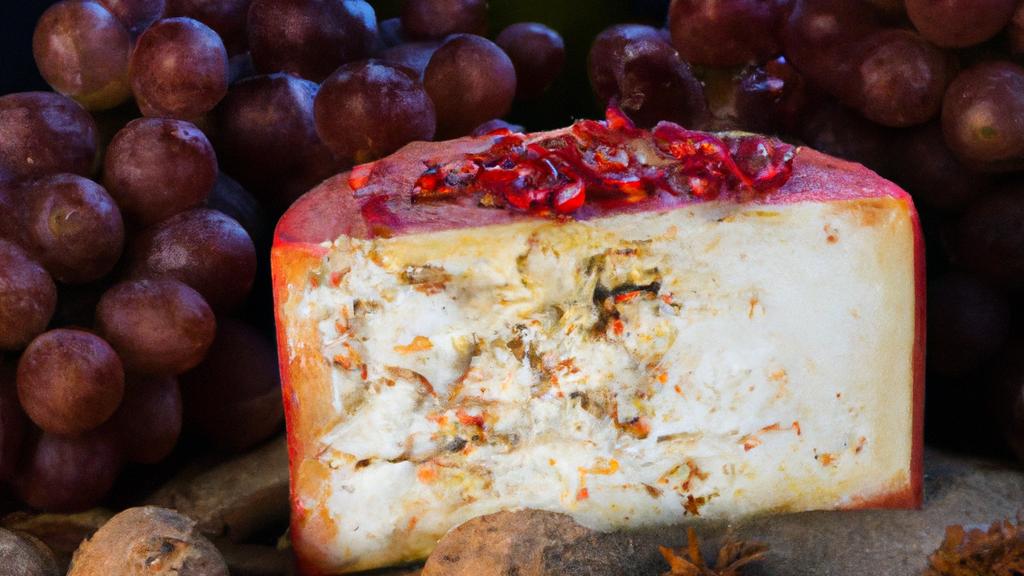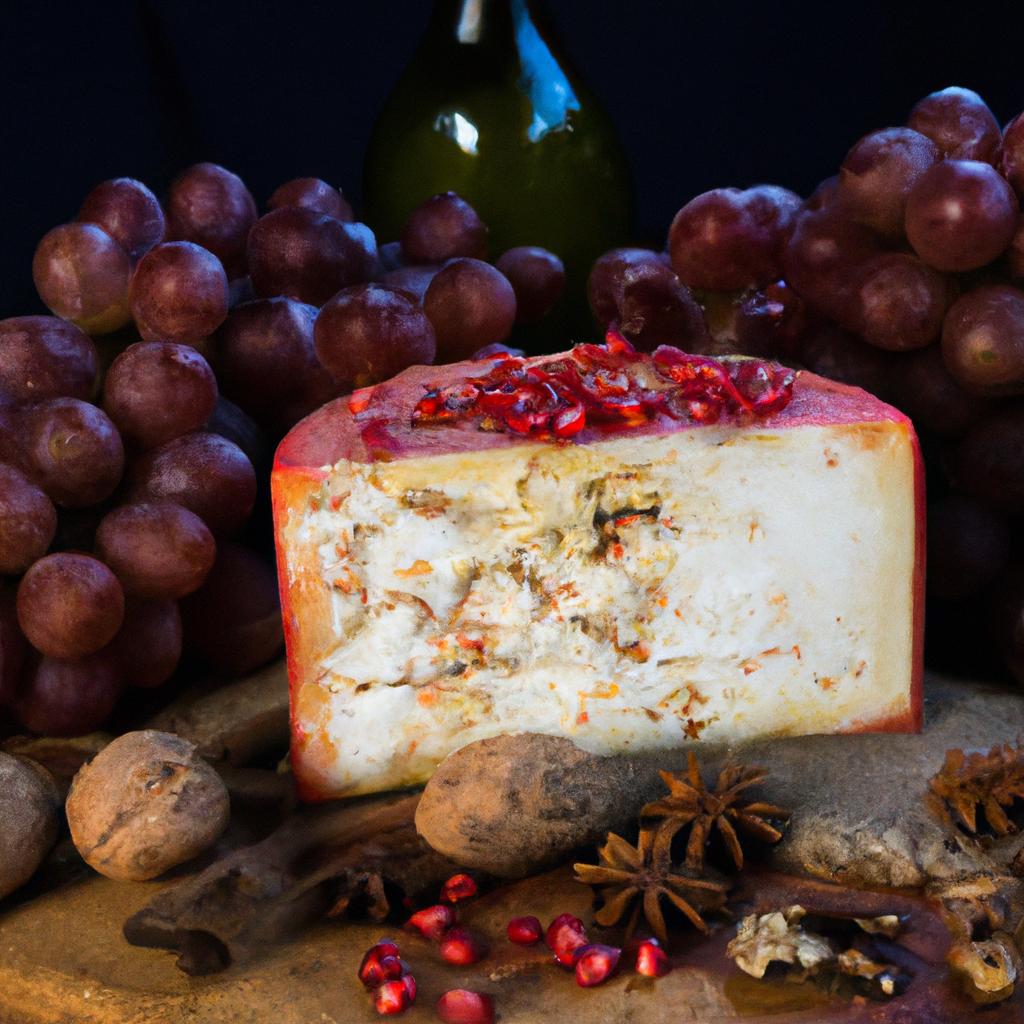
Urdă cheese, a remarkable contribution from Romania to the world’s collection of tantalizing cheeses, is a dairy delight that many food explorers would find intriguing. Urdă stands tall amidst the globally popular cheese varieties with its unique production method, texture, and flavour profile that oozes authenticity and tradition.
Urdă cheese is traditionally made from sheep’s milk, although cow’s or goat’s milk may also be used. Unlike typical cheeses that are made directly from fresh milk, Urdă cheese is crafted from whey. Whey is a byproduct obtained during the production of other cheeses, making Urdă a compelling case of waste utilization. Post the process of cheese extraction, the leftover whey liquid is heated, causing the proteins to coalesce into soft curds. With further processing, these curds transform into the incredibly creamy and mild Urdă cheese. This style of cheese is known as ricotta-style, named after the Italian cheese ricotta which is made similarly. Urdă’s texture is a delightful middle-ground between creamy and crumbly, making it a versatile ingredient in the culinary world.
Speaking of its flavor, Urdă steals the show with its nuanced simplicity. While the cheese is mild in flavor, one can discern subtle sweet notes and a faint nuttiness, intricacies which significantly depend on the animal feed. Interestingly, the type and diet of the milk-producing animal render a unique taste profile to the Urdă cheese, giving it an agricultural terroir. Urdă cheese finds use in various Romanian culinary masterpieces like sweet pies and pastries due to its accommodating flavour profile and textural charm.
- Key features of Urdă Cheese:
- Origin: Romania
- Milk Type: Traditionally from sheep, but cow’s or goat’s milk can be used
- Cheese Type: Ricotta-style, made from whey leftover from other cheese production
- Texture: A cross between creamy and crumbly
- Flavour: Mild, with subtle sweet notes and a hint of nuttiness
Welcome to our quiz on the topic of ‘Urdă Cheese’! Discover how well you know your way around this unique Romanian cheese. Are you ready to put your knowledge to the test and learn something new about this enticing dairy product? Kickstart the quiz now!

The Rich and Delicate Qualities of Urdă Cheese from Romania
Urdă cheese, a characteristic product of the Romanian gastronomic heritage, is renowned for its delicate and lactic flavors, its distinctive texture, and the artisanal process through which it’s produced. It emanates a rich and complex profile that cannot be replicated elsewhere due to its strong geographical indications and traditional manufacturing methods that have been passed down through generations.
Originated from the Carpathian mountains of Romania, Urdă is a whey cheese obtained by heating the sheep, goat, or cow’s whey remaining from the main cheese production. The heating process allows the proteins to aggregate and rise on the surface, creating a creamy and curd-like substance. The labor-intensive preparation of Urdă often requires specific knowledge, skill, and most importantly, a respect for the traditional craft. It’s then drained and shaped into small compact spherical forms, resulting in a final product that’s light, mellow, and easily spreadable with a slightly grainy texture.
On the tasting front, Urdă showcases a gentle, fresh, and lactic overtone, characterized by a hint of sweetness. Unlike other robust, vintage cheeses, Urdă cheese does not carry strong or piquant flavors, making it an excellent choice for those who prefer a subtle yet rewarding cheese experience. It also demonstrates a low salt content and a high nutritional value, enriched with proteins, calcium, and vitamins. In traditional Romanian cuisine, Urdă is used both in savory dishes, such as cozonac, and sweet treats, like brânză de burduf.
The quality of Urdă cheese largely depends on the type of milk used and the skill level of the cheesemaker. Genuine, high-quality Urdă cheese has a distinct sensory profile: a creamy white color, a crisp texture, and a sweet and milky scent. To fully appreciate the artisanal values of Urdă, consumers are advised to purchase Urdă cheese directly from Romanian farms or reputable cheese shops that value authenticity. Remember, good cheese is about quality, not quantity.
Unveiling Urdă Cheese: A Romanian Cheese Gem
Urdă cheese, is more than just a cheese, it’s a narrative of Romanian culture and gastronomy versions. It’s a cherished dairy product and is typically Handcrafted in small batches, and comes fresh to the market, giving people a taste of tradition and authenticity. The beauty of Urdă lies not only in its delightful, mild, and distinctive taste but in its carefully curated process, ingredients, and inherent health properties.
It’s fascinating that Urdă cheese is made from whey, a cheesemaking byproduct, which is heated with a small amount of milk until it separates into curd and liquid. The curd, rich in whey proteins, is then pressed and modeled into a wheel form. Being a bonne bouche, Urdă cheese might vary somewhat, imparting dissimilar subtleties of taste and texture. The milk used in the process may come from different animals such as cows, goats, or sheep. Each type of milk yields Urdă cheese with its distinctive and specific flavor profile and nutritional value.

Urdă cheese is lauded for its health properties. It is low fat, a rich source of whey proteins, and has less sodium compared with other cheeses. The romantic creaminess of Urdă blesses it with impressive versatile culinary usage. It is an important ingredient in a variety of Romanian dishes, can be used as stuffing for pies, baked dishes, as a side dish in itself or simply added to salads and desserts.
- Cow’s milk Urdă cheese: It has a mellow and smooth taste. It is typically used in pastries and desserts.
- Sheep’s milk Urdă cheese: Offers a strong and distinctive flavor which stands out in savory dishes.
- Goat’s milk Urdă cheese: It has a subtly sharp and tangy flavor, making it a good choice for stuffing in meats or vegetable dishes.
These differences created by using various milk types emphasize the manifold nature of Urdă cheese. Each one has its unique subtlety of flavor, nutrient profile, and usage, bridging the gap between culinary versatility and a feast of delightful flavors, all the while vouching for authenticity and the richness of Romanian gastronomical history.
- In Romania, Urdă cheese plays a crucial role in food culture and economy.
- Due to its taste and nutritional value, Urdă cheese has seen an increase in popularity globally.
- Traditional methods of Urdă cheese production are being preserved in rural areas of Romania.
- Urdă is often a key ingredient in other Romanian dishes, showcasing its versatility.
- With its low fat and high protein content, Urdă cheese is a favourite among health-conscious consumers.
- The process of making Urdă cheese is time-intensive, making it a valued commodity.
- In recent years, small-scale Urdă cheese producers have been recognized for contributing to the preservation of Romania’s culinary heritage.
Discover the Rich Cultural Heritage of Urdă Cheese from Romania
From the heart of Romania comes Urdă, an exquisite cheese with gentle flavors and a unique manufacturing process. The cheese originates from the Transylvania region of Romania—a picturesque land nestled amid the Carpathian mountains known for its rich cultural heritage and traditional farming practices. Predominately made by small-scale farmers, the cheese has held a profound importance in Romania’s agrarian communities for centuries.
The traditional making of Urdă is much of its charm. It begins with the separation of whey (the watery part left after milk curdles) from the curd produced during the cheesemaking process. Then, the whey is reboiled until soft clots start to form and these clots, rich in proteins and fats, are the Urdă cheese. Through this distinctive crafting, every bite savors an authentic taste that unveils the secret of Romania’s tranquil countryside and gives a nod to the traditional Romanian dairy craftsmanship.
The quality of Urdă is highly influenced by the geographical elements of the Transylvania region. The region’s natural environment – highlands and sprawling pastures – lends Urdă its distinctive flavors and textures. It’s in these pastures where the region’s dairy herds, a mix of cow, sheep, and goat, graze on a varied diet of grasses, herbs, and flowers. These elements are captured in the milk, influencing the flavors and characteristics of Urdă cheese.
Enjoying Urdă is not just a culinary experience, but also a journey into Romania’s culinary history. With a mild, fresh taste and a low level of salt, Urdă appeals to various palates. It’s often used in Romanian cuisine to prepare traditional dishes such as cozonac (a sweet bread) or placinte cu branza (cheese pie). As it’s a lower fat cheese, it’s a healthier cheese option for those watching their diet. Urdă Cheese from Romania – it’s more than just a cheese, it’s a celebration of food heritage!
Experiencing Urdă: Romania’s Creamy Gem
Urdă is a traditional Romanian cheese that demonstrates the rich dairy traditions of Eastern Europe. Delectably fresh, this whey cheese is a result of separating and boiling the curds from sheep or cow’s milk while making cheese. It resembles Italian ricotta, but the similarity ends there, as Urdă charms your palate with its unique taste and quintessentially Romanian character.
This creamy cheese is distinguished by its mild, slightly sweet taste with a harmonious hint of tang. Depending on the richness of the milk used, Urdă ranges from white to pale yellow in color. Its charmingly rustic appearance only complements its creamy mouthfeel and comforting umami essence.
Urdă is extremely versatile and can be savored in a plethora of ways. Endearingly, it is often simply spread over fresh bread, served at room temperature, necessitating little more than an appetite to appreciate its fully. However, its ability to enhance flavors extends beyond simple preparation, and it is prominently featured in several traditional Romanian recipes. Complex dishes like Plăcintă cu brânză, a layered pastry filled with Urdă cheese, sultanas, and topped with sugar, highlight the cheese’s ability to balance sweet and savory profiles.
Apart from savory and sweet dishes, Urdă is also a delight when served with the following accompaniments:
- Paired with a crisp dry white wine, it adds depth to the wine’s acidity and creates a harmonious flavor marriage.
- Combined with ripe fruits such as peaches and figs, Urdă’s creamy texture enhances the fruitiness, offering a satiating snack.
- It also pairs excellently with jams and honey, adding an interesting contrast between its savory charm and the sweet undertones of the preserves.
With its cozy flavor profiles and versatile nature, Urdă cheese beckons all cheese-lovers to take a culinary journey through the heartlands of Romania and experience its humble magnificence.
Mastering the Preservation of Unique Urdă Cheese from Romania
Renowned for its unmistakable texture and tangy flavor, Urdă cheese is a white, cottage-cheese-like product, crafted predominantly in Romania. Originating from the Balkans, this delectable dairy delicacy truly embodies the spirit of Romanian cheesemaking tradition. Significantly, proper storage of Urdă cheese is essential to maintaining its quality and longevity.
Urdă cheese is produced by heating the whey left over from making other types of cheese. The resulting curds are then strained and pressed into varied shapes, the most common one being a ball-like shape. Possessing a slightly sweet, mild taste, Urdă cheese can be enjoyed fresh, often within a few days of its creation. However, for those looking to preserve this dairy delicacy for longer durations, understanding the correct storage techniques is crucial.
Firstly, Urdă cheese should be stored in a container, typically a glass one, with a tight-fitting lid. This not only prevents external impurities from compromising the cheese’s quality but also inhibits the absorption of odors from other foods. For optimum freshness, the container should be placed in the coolest part of your refrigerator, typically at temperatures between 1 to 4 degrees Celsius (33.8 to 39.2 degrees Fahrenheit). Under these conditions, Urdă cheese can retain its quality for up to two weeks.
- When stored properly in a refrigerator, Urdă cheese can be enjoyed up to two weeks.
In addition, one can freeze Urdă cheese for longer storage periods, extending the cheese’s life for up to six months. It is advisable to divide the cheese into smaller, consumable portions before freezing, allowing for hassle-free use later. Notably, freezing could slightly alter the texture of Urdă cheese, making it more crumbly upon defrosting. Thus, while freezing is an option, enjoying Urdă cheese fresh, whenever possible, guarantees an exceptional gastronomical experience.
Discovering the Perfect Pair: Urdă Cheese from Romania and Wines
Urdă cheese, a specialised variety from Romania, is authentic, full of flavor, and rich in tradition. This white, soft, and slightly salty cheese is a fruit of the local shepherds’ expertise and rich grazing lands abundant in Romania. It’s a light chesse type, having only 1-2% fat content. Urdă cheese displays a wonderfully gentle taste that offers a subtle tang, the perfect partner for a wide range of wines. There’s a symphony of taste that takes place when this Romanian cheese is paired correctly with wines, enhancing the features and charm of both the cheese and the wine, leading to a transcendent culinary experience.
The mellow taste of Urdā cheese is often complemented with a range of wines. For whites, a semi-dry Riesling with a fruity undertone from Oltenia region is a fine choice. This combination allows for the gentle tang of the cheese to meet a match in the wine’s slight sweetness. Another option is a Chardonnay, preferably from the iconic vineyards in Cotnari. Its buttery, complex palate pairs harmoniously with the Urdā cheese’s soft character.
On the side of reds, a Fetească Neagră, a Romanian indigenous grape type, creates a remarkable pairing. This red wine is notable for its bold, full-bodied taste, raspberry aroma and velvety notes that culminate in a pleasantly astringent finish. It provides a striking contrast to the gentle Urdă, highlighting the cheese’s subtle salty hint. Additionally, a mid-aged Pinot Noir, for its medium intensity and light tannin contents, offers another appealing pairing option.
These are just a few of the wines that pair well with Urdă cheese:
- Riesling from Oltenia region (semi-dry, fruity undertone)
- Chardonnay from Cotnari vineyards (buttery, complex palate)
- Fetească Neagră (full-bodied, raspberry aroma, velvety notes)
- Mid-aged Pinot Noir (medium intensity, light tannins)
Remember, the joy of food and wine pairing relies on exploring and testing various combinations. As Urdă cheese is all about subtly and lightness, striking a balance with the wine of choice is vital so no flavour dominates the other, resulting in a harmonious dining experience.
Unveiling the Best Foods to Pair with Urdă Cheese from Romania
Originated from the scenic landscapes of Romania, Urdă Cheese is a fresh, unripened cheese celebrated for its light, delicate flavors and soft, crumbly texture. This rural milk cheese has a rich tradition and is a significant part of the country’s gastronomy, placing Romania on the global cheese map. Created from whey residue of sheep, cow, or occasionally buffalo milk and heated with fresh milk until it reaches its characteristic consistency, Urdă offers a subtle milky sweetness, making it a versatile cheese perfect for both sweet and savory dishes.
Complementing this cheese’s soft texture and delightful flavor, traditional Romanian dishes often incorporate Urdă. The well-known “Plăcintă cu brânză și mărar”, a traditional pastry filled with Urdă and dill, reveals the cheese’s capacity to enhance dishes with its subtle flavor layer. When melted, this cheese doesn’t lose its integrity, helping continually infuse the dish with its distinctive taste.
Urdă Cheese’s unique qualities make it perfect for various global dishes as well. Here are some food pairings that can elevate the Urdă experience:
- Italian-style Pasta: Sprinkle crumbled Urdă Cheese over freshly cooked pasta for a light, fresh twist on the classic spaghetti Aglio e Olio. Its mild, creamy goodness pairs excellently with the starchy noodles and subtle garlic-oil sauce.
- Homemade Pizza: A handful of Urdă Cheese over your homemade pizza can replace, or complement, the conventional Mozzarella, offering a new depth to pizza flavors.
- Baked Goods: Incorporate Urdă into your baking for a moist, fluffy texture. It can be a perfect addition to cheesecakes, muffins, pancakes, and other sweet treats. Its understated sweetness can offer a nuanced flavor without overpowering your dessert.
Exploring Urdă Cheese in different culinary contexts can significantly enhance dining experiences. If you fancy an exquisite cheese experience, don’t wait to get your hands on this Romanian delicacy, and elevate your dishes with the enticing flavors of Urdă.
Delving into the Rich Heritage of Urdă Cheese from Romania
Urdă cheese, a masterpiece of Romanian cheese making tradition, possesses an interesting background that is unique among world cheeses. This fresh soft cheese, hailing from Romania’s rural pastures, is a testament to the country’s rich dairy heritage and vibrant culinary culture. Its humble origins are deeply etched into the fabric of Romania’s farming society, making it more than just a culinary delight, but a symbol of the country’s ethos.
Historically, Urdă cheese came into existence as a means of prudent resource management. Romanian cheese makers discovered that they could obtain two types of cheese, Brânză and Urdă, from one quantity of milk. The process entails first making Brânză out of sheep’s or cow’s milk, with the remaining whey then being used to create Urdă cheese. This ingenious double cheese-making process not only reduces wastage but also yields different types of cheeses with distinct flavors and textures. While Brânză is a tangy hard cheese, Urdă is a creamy soft cheese, often used in baking and desserts due to its delicate, sweet flavor and soft texture.
Today, Urdă maintains its popularity in Romania and has also won acclaim from cheese lovers globally. The cheese is traditionally made during the summertime when dairy herds are feasting on lush mountain pastures, giving it a unique, seasonal character. As such, Urdă cheese’s creamy texture and subtly sweet, nutty undertones are a reflection of the richness of Romania’s summer pastures, becoming a treasured link between the country’s natural landscapes and its culinary palate.
- Urdă Cheese is a culinary delight that speaks volumes about Romanian dairy tradition and ingenuity in cheese-making.
- Urdă, a soft, creamy cheese is crafted from the leftover whey of Brânză production, underlining the resourcefulness of traditional Romanian cheese-makers.
- The unique taste of Urdă cheese, characterized by its subtly sweet, nutty flavors, credits its origin to the rich, summer pastures of Romania.
Unwrapping the Rich Flavors of Urdă Cheese and Its Counterparts Across the Globe
Submerged in the diverse culinary map of Romania, Urdă cheese enjoys a prized position with its unique texture and mild flavor. Holding onto an age-old recipe shared among generations, this by-product cheese is crafted from whey retained from the cheese or butter making process. Urdă manifests a crumbly texture and slightly sweet taste with caramelized undertones. Notably, in the careful hands of Romanian cheesemakers, what would typically be discarded transforms into this cherished culinary treasure.
Globally, other cheeses share some fascinating parallels with Urdă. For instance, Italian Ricotta is a close cousin recognized for its creamy texture and slightly sweet undertones. Traditionally made using a blend of whey and milk from cows or sheep, Ricotta managed to weave itself into a variety of culinary applications from desserts to pasta fillings. Similarly, the Greek Anari exhibits a parallel to Urdă. Fresh Anari, like Urdă, is soft and crumbly, ideally consumed fresh with a drizzle of honey or as a base in Greek pastries. There’s also France’s Brocciu cheese, a by-product cheese obtained mostly from ewe’s milk whey. Compared to Urdă, Brocciu owns a more pronounced, tangy flavor while maintaining a similar soft and moist texture.
Moving towards Norway, we stumble upon Mysost, a unique addition to this list. This caramel-coloured cheese is revered for its sweet, yet slightly tangy flavor and fudgy texture. Unlike Urdă, Mysost gains its distinctive sweet character from slow caramelization of milk sugars during the cheese-making process. Despite geographical boundaries, these cheeses echo shared ancestral cheese-making legacy, rendering them a unique gastronomical discovery. These include:
- Ricotta: Creamy textured Italian cheese with a slightly sweet taste.
- Anari: Soft, crumbly Greek cheese enjoyed fresh or in pastries.
- Brocciu: French counterpart of Urdă made from ewe’s milk with a tangy flavor.
- Mysost: Norwegian cheese noted for its caramel-like flavor and fudgy texture.
In essence, delving into the tale of Urdă cheese and its global counterparts isn’t merely a journey through the nuances of the culinary world, but a tribute to a cherished tradition of transforming what’s considered waste into a delicacy. Delightfully, the narrative linked to these cheeses is as rich, complex, and intriguing as their flavors themselves.


